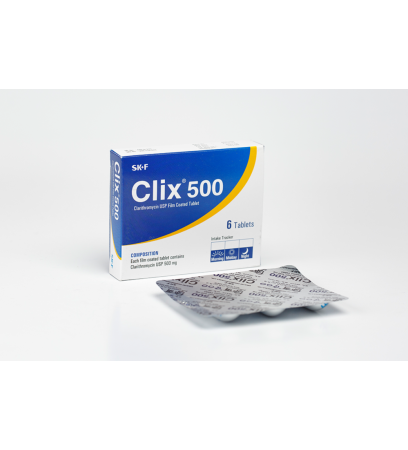Clix Tablet 500 mg
- Brand:Eskayef Pharmaceuticals Ltd
- Product Code: Clarithromycin
- Availability: In Stock
-
40.00Tk.
This product has a minimum quantity of 10
Indications
Clarithromycin is indicated in-
- Streptococcal pharyngitis
- Sinusitis
- Infective exacerbations of chronic bronchitis
- Community-acquired pneumonia
- Atypical pneumonia
- Skin and soft tissue infection
- Adjunct in the treatment of duodenal ulcers by eradication of H.pylori.
Pharmacology
Clarithromycin acts by inhibiting microsomal protein synthesis in susceptible organisms mainly by binding to the donor site on the 50S subunit of the bacterial ribosome and preventing translocation to that site. Clarithromycin is active against most Gram-positive bacteria and Chlamydia, some Gram-negative bacteria and Mycoplasmas. Clarithromycin's activity is the same as, or greater than, that of Erythromycin in vitro against most Gram-positive bacteria. Clarithromycin is more acid-stable than Erythromycin and therefore, is better tolerated. Clarithromycin has twice the activity of Erythromycin against H. influenzae. Most species of Gram-negative bacteria are resistant to Clarithromycin because of failure to penetrate the target.
Dosage
Adults:
- Pharyngitis / Tonsillitis 250 mg every 12 hours for 10 days.
- Acute maxillary sinusitis 500 mg every 12 hours for 14 days.
- Chronic bronchitis 250-500 mg every 12 hours for 7-14 days.
- Pneumonia 250 mg every 12 hours for 7-14 days.
- Uncomplicated skin & skin structure infections 250 mg every 12 hours for 7-14 days.
- Community-acquired upper and lower respiratory tract infections 250-500 mg every 12 hours for 5-14 days.
- Bodyweight under 8 kg: 7.5 mg/kg twice daily.
- Bodyweight of 8-11 kg (1-2 years): 2.5 ml (Half teaspoonful) twice daily.
- Bodyweight of 12-19 kg (3-6 years): 5 ml (One teaspoonful) twice daily.
- Bodyweight of 20-29 kg (7-9 years): 7.5 ml (One & half teaspoonfuls) twice daily.
- Bodyweight of 30-40 kg (10-12 years): 10 ml (Two teaspoonfuls) twice daily.
Administration
Clarithromycin may be given with or without meals.
Interaction
Theophylline: Concomitant use of Clarithromycin who are receiving Theophylline may be associated with an increase in serum Theophylline concentrations. Terfenadine: Clarithromycin may alter the metabolism of Terfenadine.
Contraindications
Hypersensitivity to Clarithromycin, Erythromycin, or any of the macrolide antibiotics. Patients receiving Terfenadine who have pre-existing cardiac abnormalities or electrolyte disturbances.
Side Effects
Clarithromycin is generally well tolerated. Side effects include nausea, vomiting, diarrhoea and abdominal pain. Stomatitis and glossitis have also been reported. Other side effects include headache, allergic reactions ranging from urticaria and mild skin reactions to anaphylaxis. Taste perversion may occur. There have been reports of transient central nervous system side effects including anxiety, dizziness, insomnia and hallucination.
Tags: Clix Tablet 500 mg

